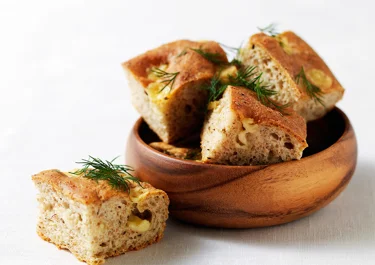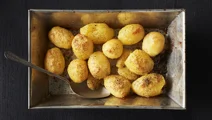Cheese bread

The smell of this cheesy and lightly baked bread is delicious. Cut it into large pieces and serve with herring or soup.
Ingredients
|
50 g
Yeast
|
|
|---|---|
|
500 ml
Water (37°C)
|
|
|
50 ml
Butter and rapeseed oil
|
|
|
250 g
Quark
|
|
|
1 tbsp
Salt
|
|
|
20 g
Dill seeds
|
|
|
300 g
Graham flour
|
|
|
540 g
Spelt flour
|
|
|
200 g
Medium-aged cheese
|
|
|
Fresh dill
|
Instructions
Cheese bread
What is the secret to making fluffy bread?
It’s all in the yeast. Use the highest quality you can find and choose fresh, over dried, yeast for a better texture and flavour. For both varieties, make sure that you check the best-before date, expired yeast is the biggest culprit for a not-so-fluffy result. Make sure that the water you dissolve the yeast in is around 28-30°C, which will ensure the yeast is activated.
What do you eat with cheese bread?
From soups and stews to a spicy arrabiata pasta and salad, almost anything goes with this recipe. It also works great as a stand-alone side for your next barbeque buffet or breakfast table.
Do you refrigerate cheesy bread?
No. As with all breads, any cold (but above freezing) environment will cause the starch to recrystalise much faster, leaving you with a hard and not-so-appetising loaf. Stick to an airtight container at room temperature, the perfect home for leftover bread (even the cheesy kind).
A fluffy, cheesy comfort food
Who doesn’t love the near blissful combination of freshly baked bread and melted pockets of stringy cheese? This recipe will be your go to side for everything from hearty soups and charcuterie plates to barbecue buffets and breakfast feasts.
The perfect starter and soup accompaniment
There are few (if any) occasions where this loaf will not fit right in. Set the scene for your dinner party by serving it either as a standalone starter or part of an elegant charcuterie board. Soup is also an obvious pairing, especially tomato and minestrone varieties that will, quite literally, make those cheesy notes sing.
Other variations – garlic and herbs
While this recipe lends itself to almost any variation, few will outshine the good old garlic and herb combo. The extra ingredients can either be worked into the dough or melted into a few tablespoons of salted butter and brushed onto the dough before baking.
How to use up leftovers
This recipe can easily be transformed into crunchy croutons that work especially well as a topping for salads, soups, and even scrambled eggs. Simply cut the leftovers into crouton-sized blocks (approx. 2 cm), drizzle with olive oil, sprinkle with spices (optional) and bake at 190°C until golden (about 15-20 minutes), turning once when you reach the halfway mark.








